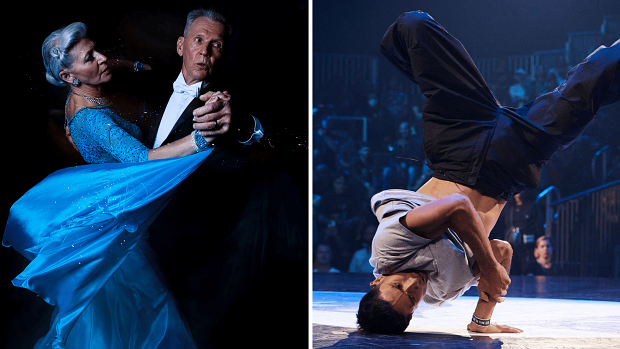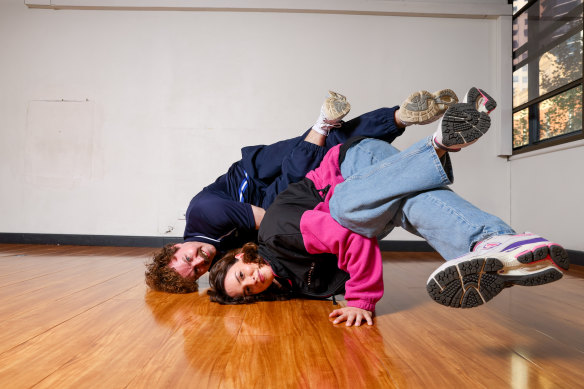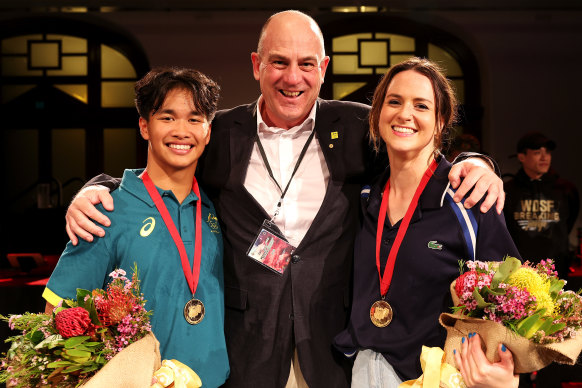This was published 11 months ago
The sport dragged into the Olympics without its consent
By Jordan Baker
Breaking is an art that grew on the street. It’s about underground dance battles and wild creativity and people who feel like outsiders. It’s still scarred by the mainstream belief that it’s a “stale joke from the ’80s”. It’s the antithesis of everything the Olympics is about.
And yet, without its consent or knowledge, breaking was co-opted into the Olympics almost by accident.

The World Dance Sport Federation wanted ballroom in the Olympics. It got breaking instead. Credit: Brook Mitchell/AP
When a decades-long campaign by the World Dance Sport Federation (WDSF) to get ballroom dancing into the Games kept failing because it was too “outdated”, the WDSF served up breaking as a youthful alternative. But no one asked the breakers. Some fought the Olympification of their art, others were persuaded by what the Games could do for it. Their views were moot. The Olympic movement is so big, it mows down everything in its path.
Suddenly, b-boys and b-girls were scrambling to set up qualifiers and federations. In Australia, accomplished breakers had to become sporting officials. While Olympic breaker Rachael Gunn, PhD, became an athlete, her breaker husband became a coach. Another top dancer, Lowe Naplan, became an administrator. “The only reason I did it was because no one else would do it,” he said. “I never really thought of [breaking] as a sport … it will always be a culture and an art form first.”
As the Paris Games draw to a close, Raygun (Gunn, 36, of Sydney) and J Attack (Jeff Dunne, 16, of northern NSW) will compete for gold in Paris. As they battle each other, there’s an undercurrent of bemusement running through a subculture that may be too cool for the Games.
At the height of disco in the 1970s, breaking grew in the disadvantaged community of New York’s Bronx. But its appropriation by the mainstream in the 1980s – think Flashdance and Electric Boogaloo – sounded its death knell, except in the hearts of the most committed hip hop artists.

Rachael Gunn and her husband and coach Samuel Free. “Having this shared interest makes our relationship feel really special,” says Free.Credit: Edwina Pickles
The arrival of video clips such as Bomfunk MC’s Freestyler in the late 1990s led to a resurgence in Australia, mostly among marginalised communities in disadvantaged areas. Eighties veterans taught a new generation. Crews, with members specialising in windmills or head spins, would hold dance battles against their rivals. “Knowledge was kind of kept within crews,” said Gunn. “So that they could have an advantage.”
Breaking was a culture. B-boys and b-girls were artists. They didn’t think of it as a sport; they didn’t see themselves as athletes. Then the Olympics came along.
Back when breakdancing, as it was then known, had been evolving in the Bronx, ballroom dancing was trying to crack the Olympics as a dance sport (a term that also covers other dance forms such as rock’n’roll and Latin). Its biggest breakthrough came in 1997, when it was recognised as a sport by the IOC. Despite this, the campaign went nowhere.
In 2014, it was still trying. The WDSF hired Jean-Laurent Bourquin, an IOC veteran turned consultant, to lobby for it to be added to the Olympic agenda.
Yet Bourquin knew that ballroom was a hopeless case. The Olympic movement worried about losing the young people, and “we’d be coming [to it] with another outdated discipline”, he told this masthead. “[The WDSF] said, ‘It’s like figure skating, [with] nice dresses, beautiful girls.’ I thought break dancing was the only one that could be attractive from a youth perspective.” So the WDSF agreed to pivot to breaking. The only issue, says Bourquin, was that it didn’t actually speak for breaking. “I discovered that a bit too late.”
Breaking was accepted into the 2018 World Youth Games. The breaking community was blindsided. Its art had been turned into an Olympic sport without its consent. High-profile b-boy Serouj Aprahamian created a petition accusing the WDSF of using breaking as a Trojan horse to get ballroom into the Olympics, and demanding that it leave his art alone. “This action is immoral, illogical, and insulting,” he wrote.
But Bourquin convinced other high-profile breakers to design a judging system that put the best in the world on the panel. “It’s like if in soccer you take Ronaldo, Messi as the referees for a new young youth tournament, and then people are excited because they say this is a legend of our sport,” he said. The breaking community – some of it, at least – slowly came on board. Paris organisers were keen, as breaking is popular in France. It was accepted as a sport for the 2024 Games.
The WDSF rejects the accusation that it took advantage of breaking. Tony Tilenni, the Australian vice president, described the Olympics as the pinnacle. “I thought every athlete would want that gold medal,” he said. “If you can accept that for diving, for soccer and football, why wouldn’t breakers want that as well?”

B-boy J Attack and b-girl Raygun after winning gold at the Oceania Championships last year.Credit: Getty
In Australia, breakers were fatalistic. “It was like, ‘Well this is in [the Olympics] now,’” Gunn said. “So we’d better make sure that we’re not being misrepresented. People were really worried about what happened in the ’80s, where the narrative kind of got carried away from what breaking was, and a lot of the culture and the history was lost. We needed to make sure that there was a seat at the table for us, even though it’s not something that we planned or necessarily dreamed of.”
In Australia, the breaking community had to scramble to comply with the rules that govern Olympic sports, such as setting up a federation. Some of the best breakers had to choose between becoming athletes and becoming officials because there was no one else to do it. Free, Gunn’s husband and coach, was one of them. “He could have gone to the Games – he’s a very high-level breaker. We have so many people who can compete, but not many people who can take these other roles.”
Some athletes have been training for the Games for most of their lives. Gunn’s Olympic journey arrived five years ago, as a curveball. Now she’s wearing green and gold, and marching in the opening ceremony.
Her Olympic journey may well be over on August 10, however, as dance sport will not feature in Los Angeles; while the French embraced it, the Americans preferred other sports such as lacrosse and squash. Its fate in Brisbane is still up in the air and may depend on how ardently the WDSF wants to push it.
Despite all the upheaval, Gunn hopes the Olympics will be good for breaking. She hopes Australia, which still bans breaking in primary schools, will see how street dance is embraced in Europe, and parts of Asia. She hopes it will inspire a new generation. “So many people don’t know anything about it. [They think] it’s this stale joke from the ’80s.”
Sign up for our Sports Newsletter to get Olympic Games updates and general sport news, results and expert analysis straight to your inbox.